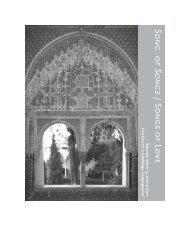BH1001, Guillaume Du Fay: Motets - Blue Heron
BH1001, Guillaume Du Fay: Motets - Blue Heron
BH1001, Guillaume Du Fay: Motets - Blue Heron
Create successful ePaper yourself
Turn your PDF publications into a flip-book with our unique Google optimized e-Paper software.
12<br />
Ecclesie militantis, and the Sanctus “Papale.” Here,<br />
as in the scoring of chansons, several defensible<br />
choices are available. In a world where the<br />
global distribution of recorded music threatens<br />
us with increasing uniformity of style even as it<br />
bewilders our ears with a plethora of repertoire<br />
to listen to, such openness to variety is surely all<br />
to the good. —Scott Metcalfe<br />
NOTES<br />
1 Alejandro Planchart suggests (in the introduction to his<br />
unpublished edition of Ecclesie militantis) that the likely occasion<br />
was the first anniversary of Eugene’s papal coronation rather than<br />
the event itself, since the week between Eugene’s election and his<br />
coronation left very little time for the text to be written and the<br />
motet composed, copied, and rehearsed.<br />
2 Leofranc Holford-Strevens, “<strong>Du</strong> <strong>Fay</strong> the poet? Problems in the texts<br />
of his motets,” Early Music History xvi (1997): 97-165, p. 131.<br />
3 David Fallows, <strong>Du</strong>fay. Revised edition. London: J. M. Dent & Sons,<br />
1987, pp. 46, 179-181. Planchart, on the other hand, dates the<br />
work to <strong>Du</strong> <strong>Fay</strong>’s first period in the papal choir from 1428-33. See<br />
his “Parts with words and without words,” in Stanley Boorman,<br />
ed., Studies in the performance of late medieval music. Cambridge:<br />
Cambridge University Press, 1983: 227-51, p. 237.<br />
4 Christopher Page, Discarding images. Oxford: Oxford University<br />
Press, 1993, pp. 163-9.<br />
5 Page makes a similar point about chanson poetry in Discarding<br />
images, pp. 162-3.<br />
6 Op. cit., p. 190.<br />
7 As suggested by Charles Warren in “Punctus organi and cantus<br />
coronatus in the music of <strong>Du</strong>fay,” in Allan W. Atlas, ed., Papers read<br />
at the <strong>Du</strong>fay quincentenary conference. Brooklyn, 1976, pp. 128-43.<br />
8 Although unascribed in its only source, the Dijon chansonnier<br />
(Dijon MS 517), it is copied there between two other anonymous<br />
songs that are elsewhere ascribed to Ockeghem. The attribution<br />
was first proposed by Ambros and has recently been supported<br />
by Sean Gallagher in “Syntax and style: rhythmic patterns in the<br />
music of Ockeghem and his contemporaries,” in Philippe Vendrix,<br />
ed., Johannes Ockeghem. Paris: Klincksieck, 1998, pp. 681-705.<br />
9 Fallows lists a number of examples in “Specific information on the<br />
ensembles for composed polyphony, 1400-1474,” in Boorman,<br />
ed., Studies in the performance of late medieval music (1983):<br />
109-59, p. 127.<br />
10 See Fallows, “Specific information.” More will be found in the<br />
articles cited in n. 11 and their bibliographies.<br />
11 Summary accounts of the debate, with references to all the<br />
pertinent literature, may be found in Kenneth Kreitner, “Bad news,<br />
or not? Thoughts on Renaissance performance practice,” Early<br />
music xxvi (1998): 323-333, and Ross <strong>Du</strong>ffin, “Early <strong>Du</strong> <strong>Fay</strong>,” in R.<br />
<strong>Du</strong>ffin, ed., A performer’s guide to medieval music. Bloomington:<br />
Indiana University Press, 2000, pp. 235-247.<br />
12 “Going beyond the limits: experiments with vocalization in the<br />
French chanson, 1340-1440,” Early music xx (1992): 446-59, p.<br />
452.<br />
13 Fallows, in the critical report to his revision of the Opera omnia<br />
edition of <strong>Du</strong> <strong>Fay</strong>’s chansons, notes that the omitted ligatures and<br />
repeated notes in the tenor of one source of this song make it a<br />
strong candidate for such treatment.<br />
14 “Fourteenth-century instruments and tunings: a treatise by Jean<br />
Vaillant? (Berkeley, MS 744),” Galpin Society Journal xxxiii (1980):<br />
17-35, p. 30.



